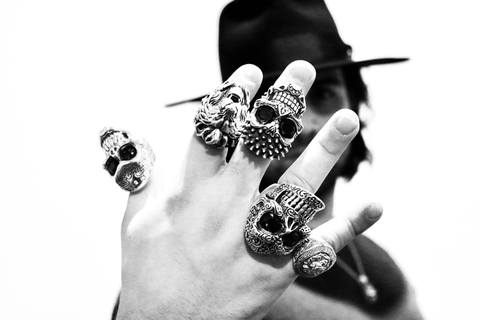THE MYSTERY OF SILVER SKULL RINGS

One of the most popular motifs in men's accessories and jewelry is a skull. It is a very ancient symbol, which, nevertheless, is still actively used to adorn accessories. The symbol of a skull unites divergent cultures and groups of people. Orthodox monks, pirates, Goths, bikers, rockers, hussars, pilots, Emos ... and many other groups utilize skulls in their symbolism. Why is this seemingly intimidating image so appealing for different people?
THE DUAL NATURE OF A SKULL
A skull is a symbol that encompasses two opposite meanings at the same time. The skull is a symbol of mortality and simultaneously, it signifies opposition to death. In ancient cultures, skulls and bones symbolized vitality and energy because bones are the most resistant organic substance that withstands decay and decomposition. The maters of life, death, and immortality have always bothered people. A skull as a two-fold symbol became an accessible signifier for various interpretations and philosophical reflections on these topics.
THE MEANING OF A SKULL IN ANTIQUITY
In ancient Rome, a skull with bones signified victory over death. This symbol was used by warriors during triumphal marches. It was always accompanied by a Latin phrase “Memento mori”. These words mean “remember that you are mortal”. Ancient Romans believed that a reminder of death added caution, skill, and dexterity to the warriors and helped them to win. A skull was a guarding angel that defended them in battles. Warriors of ancient Rome painted signs of a skull on clothing and embellished various wearable accessories.
In Western culture, the symbol of a skull has Christian roots. Traditionally, a skull with crossbones was called Adam's head. According to the legends, the dust of Adam was buried on Golgotha, a mountain where Christ was crucified. His blood washed Adam's skull and gave mankind a hope for salvation. The symbolic meaning of a skull with bones in Christianity is liberation from death and the possibility of resurrection.
SKULL - SYMBOL OF WAR
The wartimes retain many references of skulls. This symbol was extremely popular among the troops of Western Europe. The first mentions refer to the mid 19th century. It was primarily used by hussars of the Prussian army led by Frederick the Great. “Hussars with a deadhead” - “Totenkopfhusaren” put a silver skull on their black hats which supposed to symbolize the unity of war and death on the battlefield. In the XXth, the image of this sign began to appear on a silver skull ring that served as a reward in the German army.
Along with the Prussian troops, this signifier emerged in the British army. In 1855, during the Crimean War, their symbolism was complemented with a ribbon saying "OR GLORY" (meaning Death or Glory). Skulls were also used by French royalist immigrants who fought against the revolutionary regime. Later the Finnish, Bulgarian, Hungarian, Austrian, Italian, and Polish troops also adopted this symbol.
Today, the symbol of a skull is still used in military paraphernalia. Now it is utilized by mercenaries who take part in various military operations.
